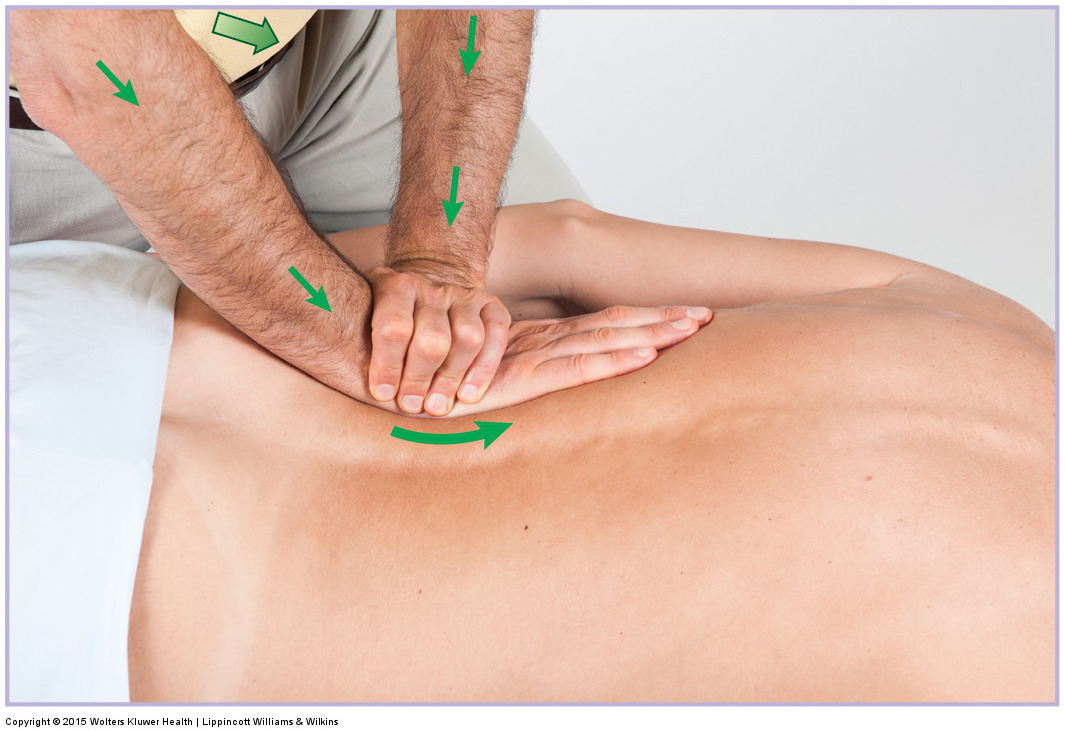Manual therapy case study of Lower Crossed Syndrome:
Kori is a 30-year-old store clerk how works at a high-end clothing store. Her low back has been tight for as long as she can remember, but she never had any pain until recently. The pain began approximately six months ago. It was occasional at first, but now she feels it most of the day, so she has decided to go to a clinical orthopedic massage therapist. She has no lower extremity referral pain. Kori also reports that she wears high heel shoes all day at work and has been wearing high heels for many years.
The therapist performed a static assessment of her posture and noted a greatly increased anterior pelvic tilt with a hyperlordotic lumbar spine (hallmark signs of lower crossed syndrome). Kori’s thoracic spine is slightly increased and her head is slightly protracted. Palpation assessment revealed tight low back extensors and hip flexors. Digital pressure over the lumbosacral region reproduced the characteristic pain that Kori has been experiencing. Kori’s abdominal wall and gluteal musculature are not well toned. Active and passive straight leg raise are negative for pain or referral of symptoms into the lower extremity; and Nachlas and Yeoman’s tests are negative. Lumbar spine ranges of motion are all within normal limits except that flexion is decreased and extension causes low back pain in the lumbar region. Hip joint extension and abduction are also decreased bilaterally.

Deep pressure into the lumbar paraspinal musculature using a braced flat palm contact. Permission: Joseph E. Muscolino. Permission: Joseph E. Muscolino. Manual Therapy for the Low Back and Pelvis – A Clinical Orthopedic Approach (2015).
Given the assessment of lower crossed syndrome, the therapist recommended two one-hour massages per week for four weeks and one one-hour massage per week for the following 8 weeks. The therapist also referred the client/patient out to a Pilates instructor with the request that the Pilates instructor pay specific focus on correcting the dysfunctional lower crossed postural pattern by increasing strength of Kori’s (core) Powerhouse.
With the client prone, soft tissue manipulation was performed on the lumbosacral spine’s paraspinal (erector spinae and transversospinalis) and quadratus lumborum musculature for approximately 5-10 minutes, gradually transitioning from mild to deeper pressure. This was followed by moist heat for an additional 5-10 minutes while the therapist worked Kori’s thoracic and cervical spine. The therapist then had Kori lie supine and massaged her hip flexors and adductors with mild to moderate pressure for 5-10 minutes. Heat was then placed on the proximal anteromedial thigh while the therapist worked the proximal belly of the psoas major through Kori’s anterior abdominal wall.
The therapist left the room while Kori then changed into flexible shorts and a top so that low back and hip joint stretching could be done without the difficulty of working with draping. The therapist performed knee to chest and double knee to chest stretches for the low back, and then stretched all sides of Kori’s hip joints bilaterally, with special attention to the hip flexors anteriorly, adductors medially, and lateral rotators posteriorly. Pin and stretch stretching technique was performed for the psoas major distal belly/tendon and for the piriformis, and contract relax (CR) stretching technique was performed for the adductor group. With the time remaining, the therapist performed joint mobilization (arthrofascial stretching) of the lumbar spine.
Each session was carried out in a similar manner, with increasing depth of pressure and assertiveness of stretching as Kori gradually improved. Kori was given self-care stretches for the hip flexors and adductors as well as her low back; and she was told to perform these stretches two to three times per day after hot shower or other form of moist heat application. And she was given posterior pelvic tilt exercises. Finally, proper posture at work and home was discussed, including the recommendation to gradually wean off of wearing high heel shoes.
At the end of twelve weeks, Kori’s pain was gone and her lower crossed syndrome postural dysfunction showed the beginning of improvement. For proactive self-care with the goal of continuing to improve her lower crossed syndrome postural distortion, Kori continues to receive clinical orthopedic massage once or twice each month and continues to do Pilates once per week with an instructor and twice per week at home on her own.


